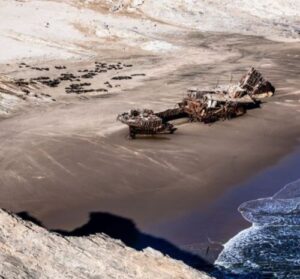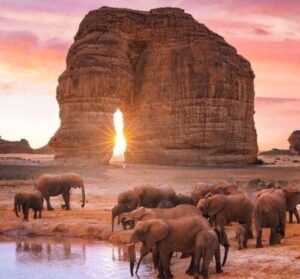 Namibia’s Skeleton Coast is a place like no other. This remote stretch of coastline runs from the Kunene River to the Swakop River. It’s famous for its harsh, desolate beauty and mysterious shipwrecks. Known as one of Africa’s most untamed regions, the Skeleton Coast gets its name from the many shipwrecks and the bones of whales and seals that once littered its shores.
Namibia’s Skeleton Coast is a place like no other. This remote stretch of coastline runs from the Kunene River to the Swakop River. It’s famous for its harsh, desolate beauty and mysterious shipwrecks. Known as one of Africa’s most untamed regions, the Skeleton Coast gets its name from the many shipwrecks and the bones of whales and seals that once littered its shores.
A Skeleton Coast safari offers a unique adventure. It combines dramatic landscapes, desert wildlife, and a true sense of isolation. While other safaris focus on wildlife in grasslands or forests, this safari takes you through an environment that feels otherworldly. The Skeleton Coast is not for the faint-hearted, but for those looking to explore Namibia’s rugged coastline, it’s unforgettable.
The Enigmatic Beauty of the Skeleton Coast
The Skeleton Coast feels like a world apart. Its foggy shores, towering dunes, and rocky cliffs create a mysterious atmosphere. Fog often blankets the area, giving it an eerie look. This fog forms when the cold Benguela current meets warm desert air. The result is a dense mist that hides the coastline for much of the year.
Shipwrecks, scattered along the coast, tell tales of danger and survival. Many ships wrecked here because of unpredictable winds, rough seas, and the blinding fog. Today, rusting remains of these ships rest along the coast, half-buried in sand, offering a glimpse into the region’s treacherous past.
Wildlife on a Skeleton Coast Safari
Despite its barren look, the Skeleton Coast is teeming with life. On a Skeleton Coast safari, you’ll see animals that have adapted to survive the harsh desert. The wildlife here is unlike anything you’ll see on a traditional African safari.
Desert-Adapted Elephants and Lions
 Desert elephants are a major attraction. These elephants are a rare sight, having learned to live in arid conditions. They travel long distances in search of food and water, often digging into dry riverbeds with their tusks to find underground water. Spotting these giants against the sandy dunes is a sight you won’t forget.
Desert elephants are a major attraction. These elephants are a rare sight, having learned to live in arid conditions. They travel long distances in search of food and water, often digging into dry riverbeds with their tusks to find underground water. Spotting these giants against the sandy dunes is a sight you won’t forget.
The Skeleton Coast is also home to desert-adapted lions. These lions have learned to go for long periods without water. Instead of drinking, they rely on moisture from the prey they catch. Watching these lions, perfectly adapted to the desert, adds a thrilling element to the safari experience.
Cape Fur Seals
Along the coastline, you’ll find huge colonies of Cape fur seals. The largest of these colonies is at Cape Cross, where tens of thousands of seals gather, especially during the breeding season. You can see the seals lounging on the beaches or swimming in the cool Atlantic waters. But this coast isn’t without predators. Brown hyenas and jackals patrol the seal colonies, waiting for opportunities to hunt.
Birdlife
Birdwatchers will love the Skeleton Coast. It’s a haven for both coastal and desert species. The nutrient-rich waters of the Atlantic attract flamingos, pelicans, and cormorants. Inland, near the rivers and oases, you’ll find birds of prey like the lanner falcon and pale chanting goshawk. The area’s birdlife is diverse, and you’ll have plenty of chances to spot them on safari.
The Stunning Landscape
The Skeleton Coast is a place of stark beauty. Sand dunes rise high above the desert floor, some towering over 300 meters. These dunes form part of the Namib Desert, which is considered the oldest desert in the world. The contrast between the dunes and the crashing Atlantic waves is breathtaking. On some days, the thick fog that rolls in from the ocean adds a surreal, otherworldly quality to the scenery.
One of the most striking features of the Skeleton Coast is the way the desert meets the sea. Vast, empty sand dunes seem to spill directly into the Atlantic. This unique landscape is one of the reasons why the Skeleton Coast is so captivating. Visitors can explore this wild terrain by land, sea, and even from the air on scenic flights.
Discovering the Shipwrecks
 The Skeleton Coast is infamous for its shipwrecks. This area is often called the “graveyard of ships” because of the many vessels that have run aground here. Today, rusting shipwrecks dot the shoreline, some partially buried in sand. The most famous of these wrecks is the Eduard Bohlen, a cargo ship that ran aground in 1909. The ship now lies inland, far from the water’s edge, a victim of the ever-shifting sands.
The Skeleton Coast is infamous for its shipwrecks. This area is often called the “graveyard of ships” because of the many vessels that have run aground here. Today, rusting shipwrecks dot the shoreline, some partially buried in sand. The most famous of these wrecks is the Eduard Bohlen, a cargo ship that ran aground in 1909. The ship now lies inland, far from the water’s edge, a victim of the ever-shifting sands.
Another notable wreck is the Dunedin Star. This British cargo ship ran aground in 1942, and the story of its crew’s survival is legendary. Exploring these shipwrecks adds a layer of history to your Skeleton Coast safari. The eerie sight of these rusting vessels against the desolate landscape is unforgettable.
A True Adventure on the Skeleton Coast
The Skeleton Coast offers more than just wildlife and shipwrecks. It’s an adventure that takes you into one of the most remote and wild places on Earth. Few people get to experience this kind of isolation. The feeling of solitude, combined with the harsh beauty of the landscape, makes this safari truly unique.
Guided game drives allow visitors to explore the area while learning about its ecology and history. For a different view, take a scenic flight over the coast. From the air, you can see the vastness of the desert and the rugged coastline in one sweeping view. It’s an experience that stays with you long after you leave.
For those looking for more action, dune boarding or hiking in the Namib Desert offers an adrenaline rush. Scaling the steep dunes is challenging, but the views from the top are well worth the effort.
Conservation and Sustainable Tourism
The Skeleton Coast’s delicate ecosystem needs careful protection. Namibia leads the way in conservation, and much of the Skeleton Coast is protected as part of Skeleton Coast National Park. Visitors are encouraged to respect the environment by staying on designated paths and avoiding disturbing wildlife.
Many safari operators in the region follow strict guidelines to minimize human impact. They work with local communities to ensure that tourism benefits the area without harming its natural resources. Choosing eco-friendly tour operators helps support these conservation efforts.
When to Visit the Skeleton Coast
The best time to visit the Skeleton Coast depends on what you want to see. From May to September, the coastal fog is at its thickest, giving the landscape an ethereal look. It’s a great time for photography and exploring the shipwrecks, as the fog adds a sense of mystery to your safari.
For wildlife viewing, the dry season from June to October is ideal. Animals gather around the few available water sources, making them easier to spot. If you’re interested in seeing the Cape fur seals, visit between November and December during the breeding season. The beaches are crowded with thousands of seals during this time.
The Skeleton Coast Safari: An Unforgettable Experience
A Skeleton Coast safari is a journey into one of Africa’s last true wildernesses. It’s a place where the desert meets the sea, where shipwrecks tell tales of survival, and where wildlife thrives in one of the harshest environments on Earth. From desert-adapted elephants and lions to massive seal colonies, the Skeleton Coast offers a safari experience unlike any other.
This is a place for adventurers, photographers, and those who want to experience Namibia’s wild side. Whether you’re exploring shipwrecks, watching wildlife, or just soaking in the breathtaking views, a Skeleton Coast safari is an experience you’ll never forget. It’s a journey into the heart of one of Africa’s most rugged and beautiful landscapes.



